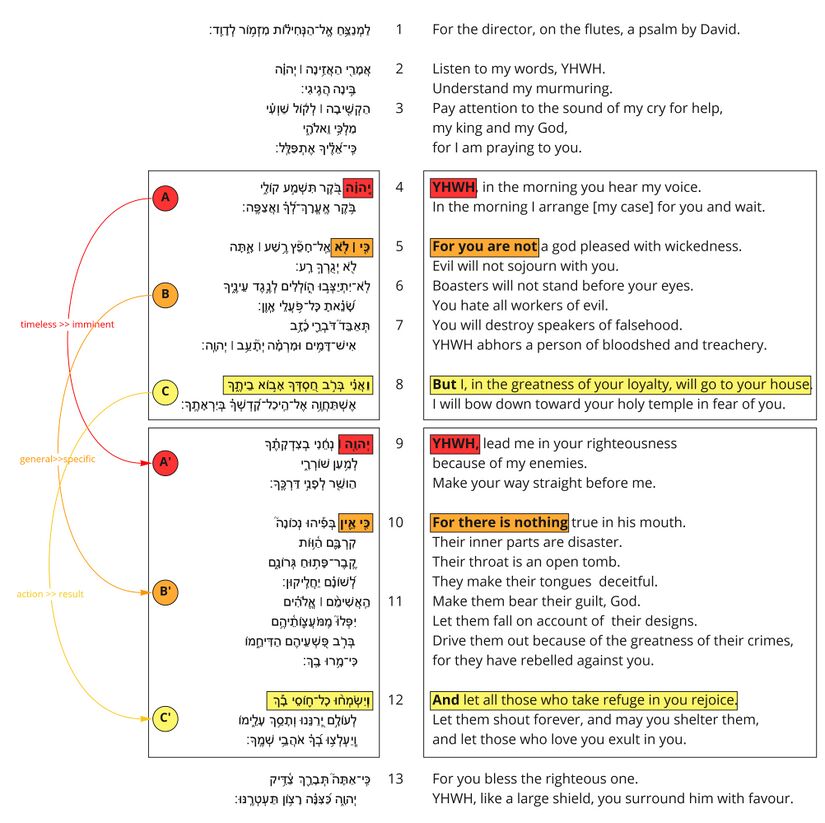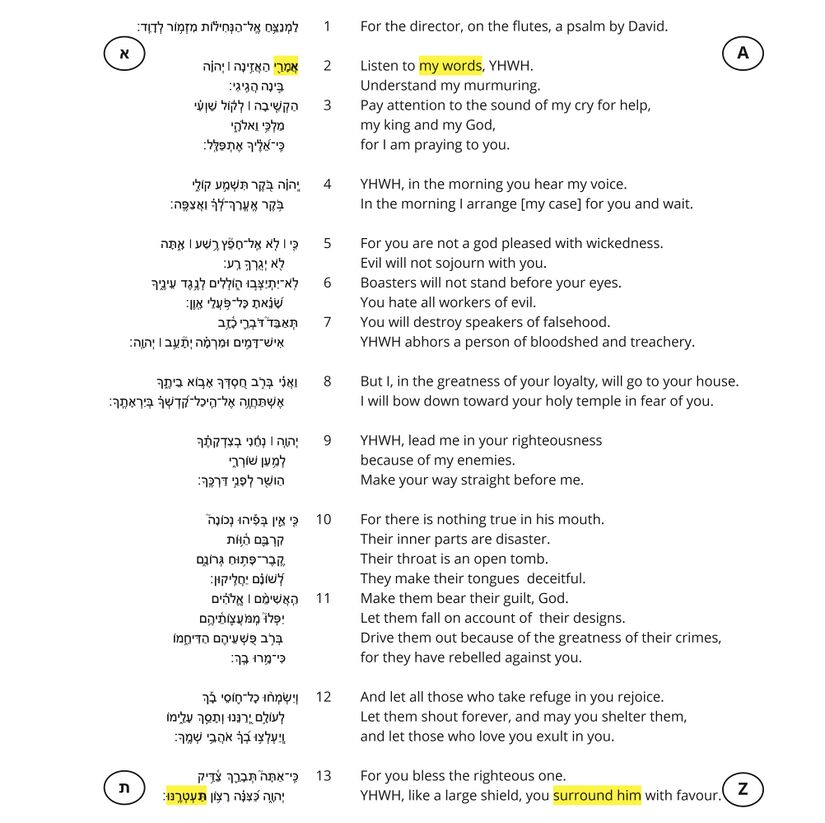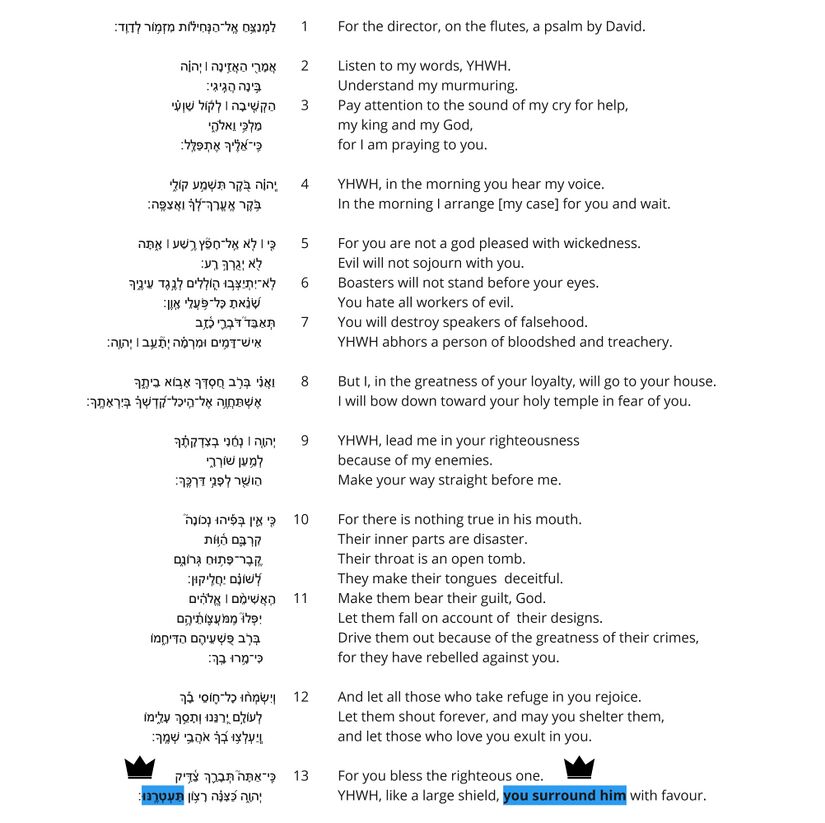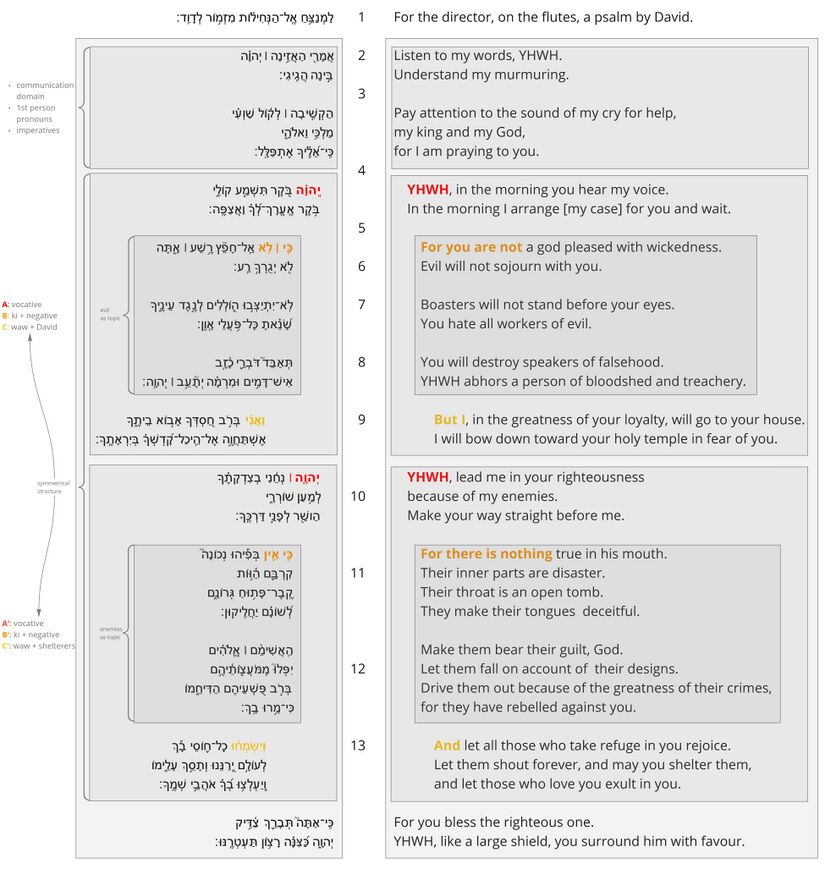Psalm 5 Poetics: Difference between revisions
m (Text replacement - "|761px" to "|825px") |
No edit summary |
||
| Line 9: | Line 9: | ||
There is dynamic movement within this structure of repetition (ABC//A'B'C). The '''A''' section (v. 4) is timeless statement, while the '''A'''' section is an imminent request. The '''B''' section (vv. 5-7) speaks about wickedness is general terms, while the '''B'''' section (vv. 10-11) speaks about "my enemies" in particular. The '''C''' section (v. 8) and '''C'''' section (v. 12) relate to one another sequentially: first the king returns (v. 8), then the people rejoice (v. 12). | There is dynamic movement within this structure of repetition (ABC//A'B'C). The '''A''' section (v. 4) is timeless statement, while the '''A'''' section is an imminent request. The '''B''' section (vv. 5-7) speaks about wickedness is general terms, while the '''B'''' section (vv. 10-11) speaks about "my enemies" in particular. The '''C''' section (v. 8) and '''C'''' section (v. 12) relate to one another sequentially: first the king returns (v. 8), then the people rejoice (v. 12). | ||
[[File: Psalm 5 | [[File:Psalm 5 Poetic Feature 1.jpg|825px|class=img-fluid]] | ||
===Effect=== | ===Effect=== | ||
The parallels in content and formal features between vv. 4-8 and vv. 9-12 structure the Psalm into two main parts, framed by an introduction and a closing: | The parallels in content and formal features between vv. 4-8 and vv. 9-12 structure the Psalm into two main parts, framed by an introduction and a closing: | ||
| Line 22: | Line 22: | ||
===Feature=== | ===Feature=== | ||
Psalm 5 begins with a word that begins with א (the first letter of the Hebrew alphabet) and ends with a word that begins with ת (the last letter of the Hebrew alphabet). | Psalm 5 begins with a word that begins with א (the first letter of the Hebrew alphabet) and ends with a word that begins with ת (the last letter of the Hebrew alphabet). | ||
[[File: Psalm 5 | [[File:Psalm 5 Poetic Feature 2.jpg|825px|class=img-fluid]] | ||
===Effect=== | ===Effect=== | ||
The alphabet is a symbol of completeness. By beginning with the first letter of the alphabet and ending with the last letter of the alphabet, the Psalm gives the impression of completeness. The Psalmist has made a complete and air-tight case before YHWH. | The alphabet is a symbol of completeness. By beginning with the first letter of the alphabet and ending with the last letter of the alphabet, the Psalm gives the impression of completeness. The Psalmist has made a complete and air-tight case before YHWH. | ||
| Line 28: | Line 28: | ||
===Feature=== | ===Feature=== | ||
The last word of the Psalm (תעטרנו), depending on how it is vocalised, could mean either "surround" (''qal'') or "crown" (''piel''). The MT reads it as "surround," while most of the ancient versions along with some medieval Hebrew manuscripts read it as "crown." | The last word of the Psalm (תעטרנו), depending on how it is vocalised, could mean either "surround" (''qal'') or "crown" (''piel''). The MT reads it as "surround," while most of the ancient versions along with some medieval Hebrew manuscripts read it as "crown." | ||
[[File: Psalm 5 | [[File:Psalm 5 Poetic Feature 3.jpg|825px|class=img-fluid]] | ||
===Effect=== | ===Effect=== | ||
The last word of the Psalm is an instance of sound play: the word "surround" sounds like the word for "crown." Psalm 5 thus ends with an allusion to its author: David, the king (v. 1), whom God has blessed and crowned (cf. Ps. 21:4). | The last word of the Psalm is an instance of sound play: the word "surround" sounds like the word for "crown." Psalm 5 thus ends with an allusion to its author: David, the king (v. 1), whom God has blessed and crowned (cf. Ps. 21:4). | ||
=Poetic Units= | =Poetic Units= | ||
==Sections== | ==Sections== | ||
[[File: Psalm 5 | [[File:Psalm 5 Poetic Units.jpg|825px|class=img-fluid]] | ||
==Verses== | ==Verses== | ||
===v. 1=== | ===v. 1=== | ||
Revision as of 23:06, 2 October 2022
Back to Psalm 5
Top Poetic Features
1. Parallel Sections
Feature
The two main sections of the Psalm (vv. 4-8 // vv. 9-12) parallel one another in multiple ways. The first verse of each section (vv. 4 // v. 9) begins with the vocative YHWH and has YHWH as its subject. The next part of each section (vv. 5-7 // vv. 10-11) begins with the subordinating particle כי followed by a negative marker (אין/לא) and a verbless clause, and it has the wicked as its main topic. The final verse of each section (v. 8// v. 12) begins with waw and has David/the righteous as its subject.
There is dynamic movement within this structure of repetition (ABC//A'B'C). The A section (v. 4) is timeless statement, while the A' section is an imminent request. The B section (vv. 5-7) speaks about wickedness is general terms, while the B' section (vv. 10-11) speaks about "my enemies" in particular. The C section (v. 8) and C' section (v. 12) relate to one another sequentially: first the king returns (v. 8), then the people rejoice (v. 12).

Effect
The parallels in content and formal features between vv. 4-8 and vv. 9-12 structure the Psalm into two main parts, framed by an introduction and a closing:
- Introduction (vv. 2-3)
- PART 1: A (v. 4) B (vv. 5-7) C (v. 8)
- PART 2: A' (v. 9) B' (vv. 10-11) C' (v. 12)
- Closing (v. 13)
The movement of the psalm happens within this structure.
2. The A to Z
Feature
Psalm 5 begins with a word that begins with א (the first letter of the Hebrew alphabet) and ends with a word that begins with ת (the last letter of the Hebrew alphabet).

Effect
The alphabet is a symbol of completeness. By beginning with the first letter of the alphabet and ending with the last letter of the alphabet, the Psalm gives the impression of completeness. The Psalmist has made a complete and air-tight case before YHWH.
3. Finish With a Crown
Feature
The last word of the Psalm (תעטרנו), depending on how it is vocalised, could mean either "surround" (qal) or "crown" (piel). The MT reads it as "surround," while most of the ancient versions along with some medieval Hebrew manuscripts read it as "crown."

Effect
The last word of the Psalm is an instance of sound play: the word "surround" sounds like the word for "crown." Psalm 5 thus ends with an allusion to its author: David, the king (v. 1), whom God has blessed and crowned (cf. Ps. 21:4).
